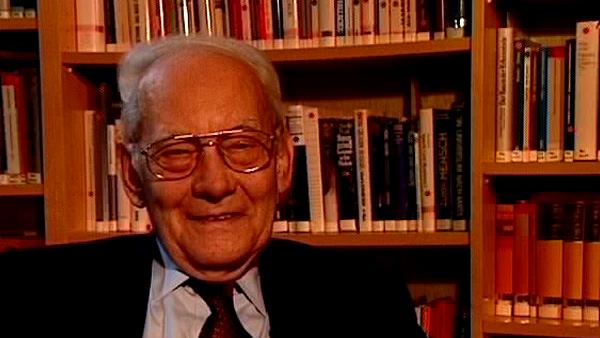NEXT STORY

Giving a lecture on sound velocity in heavy water
RELATED STORIES

NEXT STORY

Giving a lecture on sound velocity in heavy water
RELATED STORIES


|
Views | Duration | |
|---|---|---|---|
| 11. Getting pretty arrogant during my studies | 280 | 04:31 | |
| 12. Measuring electrolyte solutions | 217 | 01:00 | |
| 13. Converting my diploma thesis to a doctoral thesis | 246 | 01:37 | |
| 14. Physical chemistry had a great tradition in Göttingen | 319 | 02:07 | |
| 15. Burying Nernst three times | 295 | 02:21 | |
| 16. Studying with some of the greatest people in physics | 357 | 01:19 | |
| 17. Becoming interested in fast reactions | 251 | 02:04 | |
| 18. Immeasurably fast reactions | 276 | 02:31 | |
| 19. Giving a lecture on sound velocity in heavy water | 227 | 02:10 | |
| 20. Sound absorption in sea water | 263 | 01:35 |


You can easily calculate that if the reaction would appear at every collision, at every encounter between the two ions, then... and if the concentration of the ions were 1 molar, 1 mol/l, then the half-time of such a reaction should be only a fraction of a nanosecond, that means something like 10-10 seconds. And now the difficulty is, in order to measure the rate you have to bring together the two reactants, let's say the barium ion and the sulphate ion, by mixing two solutions, one containing the barium the other containing the sulphate. Or, in the case of neutralisation reaction, taking an acid solution which has an excess of protons and a base solution, basic solution, which has an excess of hydroxyl ions, and so that the proton and the hydroxyl ion can combine to a water molecule.
Now the difficulty is the mixing has to be complete, otherwise what you see is not the reaction, but is the mixing of the two substances, and that cannot easily be effected, not even in a sophisticated apparatus in less than a millisecond, less than a thousandth of a second. What happens is that you have to put these solutions under high pressure together and make a turbulent mixture of the two and then it flows down through an outlet, and that can't be effected in less than a millisecond. In fact, to get down to a millisecond was already a great success by Hartridge and Roughton in England. They developed a flow device in which they... before them the shortest times one could measure were in the range of seconds to minutes, and they managed with this device, flow device, to get down to a thousandth of a second, to a millisecond, and that was about the... and one thought, well, for a reaction to trigger you have to bring together the partners and that can't be effected in a time shorter, therefore he called it immeasurably fast reactions.
Nobel Prize winning German biophysical chemist, Manfred Eigen (1927-2019), was best known for his work on fast chemical reactions and his development of ways to accurately measure these reactions down to the nearest billionth of a second. He published over 100 papers with topics ranging from hydrogen bridges of nucleic acids to the storage of information in the central nervous system.
Title: Immeasurably fast reactions
Listeners: Ruthild Winkler-Oswatitch
Ruthild Winkler-Oswatitsch is the eldest daughter of the Austrian physicist Klaus Osatitsch, an internationally renowned expert in gas dynamics, and his wife Hedwig Oswatitsch-Klabinus. She was born in the German university town of Göttingen where her father worked at the Kaiser Wilhelm Institute of Aerodynamics under Ludwig Prandtl. After World War II she was educated in Stockholm, Sweden, where her father was then a research scientist and lecturer at the Royal Institute of Technology.
In 1961 Ruthild Winkler-Oswatitsch enrolled in Chemistry at the Technical University of Vienna where she received her PhD in 1969 with a dissertation on "Fast complex reactions of alkali ions with biological membrane carriers". The experimental work for her thesis was carried out at the Max Planck Institute for Physical Chemistry in Göttingen under Manfred Eigen.
From 1971 to the present Ruthild Winkler-Oswatitsch has been working as a research scientist at the Max Planck Institute in Göttingen in the Department of Chemical Kinetics which is headed by Manfred Eigen. Her interest was first focused on an application of relaxation techniques to the study of fast biological reactions. Thereafter, she engaged in theoretical studies on molecular evolution and developed game models for representing the underlying chemical proceses. Together with Manfred Eigen she wrote the widely noted book, "Laws of the Game" (Alfred A. Knopf Inc. 1981 and Princeton University Press, 1993). Her more recent studies were concerned with comparative sequence analysis of nucleic acids in order to find out the age of the genetic code and the time course of the early evolution of life. For the last decade she has been successfully establishing industrial applications in the field of evolutionary biotechnology.
Tags: immeasurably fast reactions, flow device, neutralisation reaction, Francis John Worsley Roughton, Hamilton Hartridge
Duration: 2 minutes, 32 seconds
Date story recorded: July 1997
Date story went live: 24 January 2008